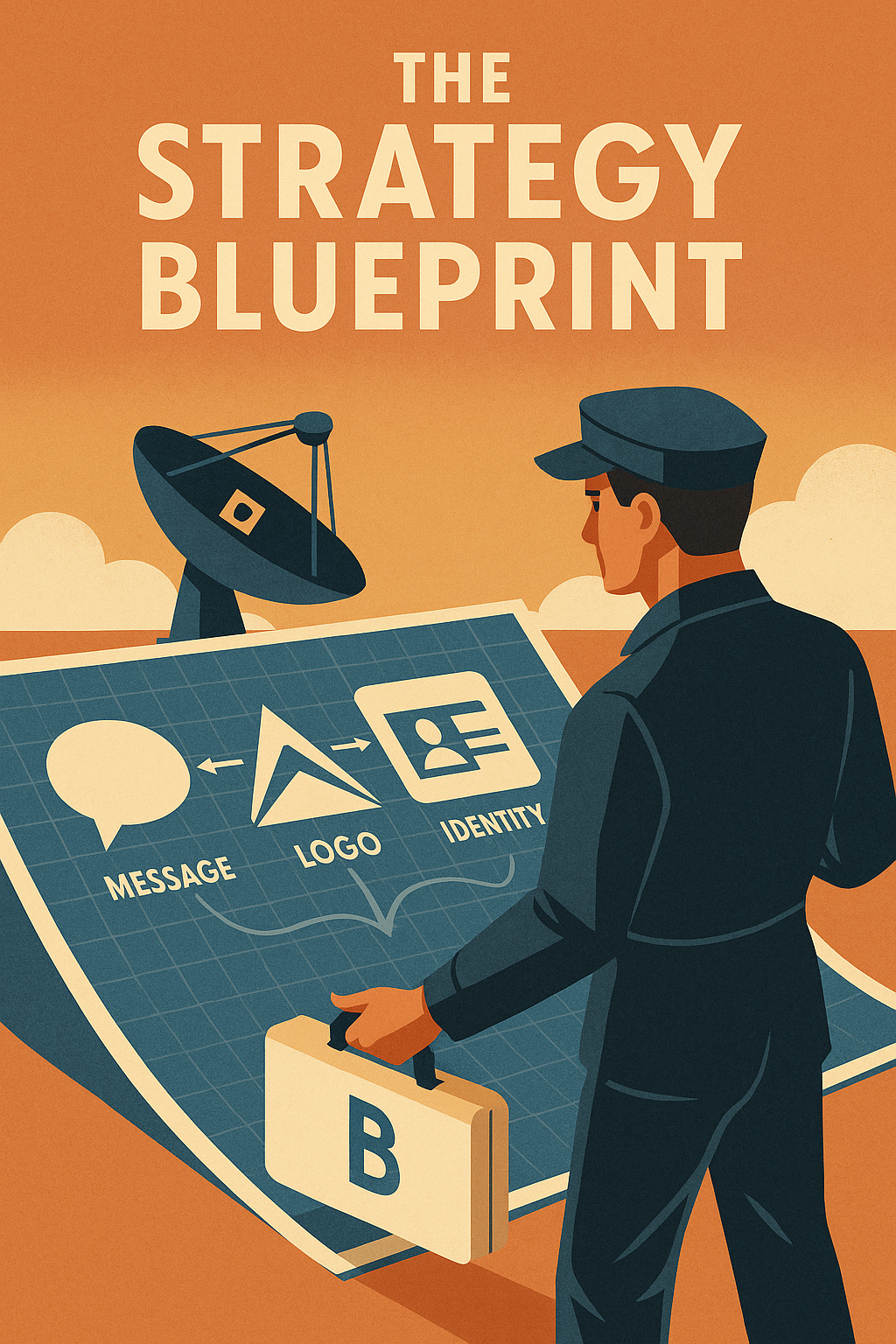You’ve got a cutting-edge defense tech business, but here’s the catch: no one’s biting.
It’s not because your solutions lack value—it’s because your brand isn’t pulling its weight. In the defense sector, especially for contractors and government vendors, your brand isn’t just a nice-to-have.
It’s the sharp edge that cuts through procurement red tape and makes decision-makers take notice.
I’m Viktor, a strategist who’s spent over a decade helping firms and B2B brands close over $500 million in contracts and partnerships.
And here’s what I know: a brilliant solution with a flat brand falls flat. But a razor-sharp brand? That’s your in.
This guide will show you how to turn your brand into a deal-closing tool—an asset that builds trust, earns visibility, and makes procurement officers and stakeholders lean in. Ready to go from overlooked to overbooked? Let’s get to work.
Why Brand Matters for Contractors in the Defense Sector
Establishing Trust and Credibility
In the defense sector, defense contractors and government contractors must navigate complex procurement processes and stringent standards. In this landscape, your brand serves as a shorthand for reliability, professionalism, and capability.
A well-executed brand strategy builds credibility by consistently signaling:
Proven Performance and Thought Leadership: Showcasing past contracts, certifications, and contributions to defense technology discussions positions your company as a seasoned and reliable player.
Alignment with Defense Department Values: A brand that echoes the defense industry’s commitment to mission-readiness, compliance, and innovation instills confidence in stakeholders.
Commitment to Innovation and Quality: Whether you specialize in cyber defense, aerospace systems, or advanced logistics, your brand identity should communicate a focus on cutting-edge defense products and uncompromising quality.
Government contractors must also account for how branding efforts affect perceptions across key industry players.
A strong brand identity becomes essential in ensuring all marketing materials—websites, proposals, white papers—reinforce trust and expertise in every interaction. This builds long-term brand loyalty and elevates your company’s stand in a competitive market.
Influencing Decision-Makers
Winning a defense contract is about influencing an entire network of stakeholders.
Engineers, acquisition officers, compliance teams, and program managers all weigh in.
This is where cohesive brand messaging and strategic marketing efforts become invaluable.
A strong brand helps you:
Clarify Complex Value Propositions: Make your technical capabilities and mission alignment clear with every pitch and proposal.
Enhance Brand Visibility: Through strategic marketing campaigns and digital marketing efforts—including LinkedIn, search engine optimization, and direct marketing—you reach decision-makers at multiple touchpoints.
Build Relationships with Key Stakeholders: Your brand becomes a vehicle for engaging with stakeholders long before and after the bid process, contributing to active participation in industry discussions and events.
In a sector driven by credibility and consistency, brand building isn’t a luxury—it’s a strategic approach that helps defense contractors and industry partners stand out in a competitive space.
By embedding brand strategy into your core marketing services and business development, you enhance your visibility, influence, and ultimately, your ability to win contracts.
Defense contracts involve multiple stakeholders, including engineers, compliance officers, and program managers. A clear, cohesive brand makes it easier for all of them to understand your value proposition quickly and consistently.

Building a Strong Brand Strategy
Clarify Your Brand Identity
A strong brand identity is the cornerstone of successful marketing strategies in the defense industry.
For any defense contractor or government contractor, clearly defining your brand ensures you communicate value, build trust, and maintain consistency across all channels—from logo design to LinkedIn content.
Here’s how to start building a strong brand identity:
Mission & Vision: Define why your contractor business exists and what role it plays in the future of defense technology. Are you helping defense agencies stay ahead of cyber threats? Are you revolutionizing aerospace logistics? This clarity allows your brand presence to resonate with both current stakeholders and potential clients.
Positioning: What makes your company stand out in a competitive defense sector? Your brand strategy should carve out a distinctive position in the minds of procurement officers and industry partners. Whether you focus on innovation, reliability, or speed of deployment, make your contractor advantage clear.
Personality & Tone: Defense marketing isn’t one-size-fits-all. Establish a communication style—authoritative, visionary, or collaborative—that aligns with your audience and supports consistent messaging across all marketing campaigns and communication channels.
These foundational elements of brand building will influence everything from your visual identity to your B2B marketing efforts, ensuring your company can stand out and scale in both traditional defense contracting and emerging defense markets.
Craft a Compelling Brand Message
Your brand messaging should be as mission-ready as the defense products and services you provide.
To craft messaging that wins:
Solve Real Problems: Show exactly how your products or services help defense agencies and government partners address urgent priorities like AI adoption, supply chain resiliency, or secure communications. Speak directly to defense sector challenges.
Use Case Studies & Proof Points: Government contractors build credibility by showcasing successful projects and collaborations with key industry players. Case studies should highlight compliance with defense standards, contribution to readiness, or innovative use of defense technology.
Align with Industry Trends: Tailor your messaging to reflect the evolving strategy in the defense industry—topics like autonomous systems, space defense, and hybrid warfare. Speak the language of defense marketing.
A compelling brand message is not just about what you offer, but how it fits into the broader goals of national security and defense readiness. It positions your company not just as a vendor—but as a trusted leader in the defense sector. Successful contractors communicate with precision:
Highlight how your products or services solve critical defense needs.
Use case studies to show real-world results.
Align messaging with current defense sector priorities (e.g., cybersecurity, AI, readiness).

Tactical Brand Components That Close Deals
Logo and Visual Identity
Ensure your logo, typeface, and design system convey stability, professionalism, and innovation. These visual cues set expectations before a single word is read.
Consistent Brand Messaging
Every proposal, LinkedIn post, and slide deck should echo the same value proposition. Use consistent tone, terminology, and visual style.
Robust Online Presence
Website: Optimized for SEO and structured for procurement and decision-makers.
LinkedIn: Thought leadership, case studies, and industry engagement.
Content Marketing: White papers, reports, and blogs addressing defense contracting pain points.

Marketing Services That Amplify Brand Credibility
Digital Marketing for the Defense Industry
A defense contractor’s digital presence is often the first—and sometimes only—impression procurement officers and stakeholders get. That’s why defense marketing needs more than generic B2B outreach; it requires a precision-guided digital strategy tailored to the defense sector’s unique challenges.
Modern marketing services for the defence industry should include:
SEO Strategies Optimized for Search Engines and Procurement Needs: Incorporate high-intent, DoD-specific keywords such as “cyber defense contractor,” “CMMC compliant vendors,” or “military-grade logistics solutions.” Ensure that all marketing materials and web assets are optimized for search engines and aligned with how government agencies conduct vendor discovery.
Paid LinkedIn Campaigns for Government and Defense Stakeholders: Use LinkedIn’s powerful targeting to reach acquisition officers, compliance managers, and decision-makers within defense organizations. Smart LinkedIn marketing campaigns increase brand visibility and keep your brand top-of-mind during the procurement process.
Retargeting and Direct Marketing Ads: Leverage retargeting ads to re-engage site visitors who have already shown interest. These tailored marketing campaigns help defense contractors stay visible throughout the long and complex government contracting journey.
By working with a specialized marketing agency familiar with government and defense, you can implement marketing strategies that directly support brand building, strengthen your online brand presence, and help defense contractors win more bids.
B2B Content Creation
Defense contracting buyers aren’t swayed by fluff; they seek depth, proof, and alignment with mission-critical objectives. Your content must reflect technical authority and strategic value.
Strategic B2B content creation for defense contractors includes:
In-Depth Compliance Guides: Create ultimate guides covering government contractor regulations, defense contracting best practices, and program-specific compliance like ITAR, CMMC, and DFARS.
ROI-Focused Solution Breakdowns: Help defense stakeholders understand the operational and financial impact of your services. Quantify benefits and align them with procurement metrics.
Industry Thought Leadership: Contribute to defense sector conferences, military publications, and think-tank discussions. Establish your team as industry experts actively contributing to defense technology advancement.
By aligning your content strategy with government and defense interests, you don’t just communicate—you command attention. This is how brand strategy helps contractors establish brand credibility, support marketing and sales, and stand out in the competitive defense contracting landscape. Develop high-authority, technically sound content that speaks to engineers and procurement leaders. Examples:
In-depth guides to defense contracting compliance
ROI-focused breakdowns of your solutions
Contributions to industry conferences and publications

Integrating Brand into Business Development
Branding as a Bid Tool
In the defense contracting world, the strength of your brand can be the deciding factor in a competitive bid. As a defense contractor or government contractor, integrating branding into your proposal strategy is a high-impact way to differentiate your offer and build confidence among evaluators.
Here’s how a strategic brand strategy enhances your bidding success:
Embed Your Brand Promise in Executive Summaries: Every RFP response should open with a clear, confident articulation of what your brand stands for—be it innovation in defense technology, mission alignment with DoD priorities, or unmatched compliance expertise. This frames your value in terms that resonate with stakeholders and procurement officials.
Ensure Cohesive, Professional Presentation: From logo placement to formatting, your proposal should visually reflect the professionalism and reliability of your brand. Consistency across marketing materials and bid documents strengthens your brand visibility and reinforces trust throughout the procurement process.
Leverage Brand Reputation in Past Performance: Use past performance narratives to highlight your reputation in the defense sector. Reference successful collaborations with government and defense agencies, contributions to military readiness, or unique innovations that align with current industry standards.
An optimized bid package reflects more than capabilities—it demonstrates your company’s identity, reliability, and readiness to lead.
Partnering with Industry Players
Strong brands attract top-tier industry partners, opening doors to new markets and increasing your exposure to high-value contract opportunities.
Your brand’s influence in building industry partnerships includes:
Boosting Co-Bid and Subcontractor Opportunities: A well-established, visible brand makes your firm a preferred partner for teaming agreements and joint ventures. Prime contractors seek subcontractors with clear positioning and a proven track record.
Elevating Your Standing in Subcontractor Networks: Defense primes and government entities alike look for subcontractors who align with their standards and can represent their reputation well. A strong brand identity signals that you are capable, trustworthy, and procurement-ready.
Demonstrating Value to Prime Contractors: Whether it’s thought leadership, innovative defense products, or a reputation for reliability, your branding communicates how you contribute to mission success. This increases your appeal as a strategic partner in high-stakes government and defense contracts.
In a market shaped by credibility and competition, investing in brand building is one of the most effective marketing services to help defense contractors grow their influence and win more bids. Strong brands attract strong partners. A recognizable, reputable brand:
Increases co-bid opportunities
Enhances your standing in subcontractor networks
Shows value to prime contractors

Case Example: Branding a Mid-Tier Defense Contractor
To understand the power of an effective brand strategy in the defense sector, consider this real-world example:
A mid-tier defense contractor specializing in aerospace systems faced stagnation in a highly competitive market. Despite their technical excellence and two decades of service—including NATO-aligned operations—their brand presence was outdated, inconsistent, and lacking visibility among government contractor directories and defense sector stakeholders.
The Brand Overhaul Strategy
Working with a specialized marketing agency focused on government and defense, the contractor implemented a multi-faceted brand-building strategy:
Elevated Brand Identity: They updated their logo, color palette, and visual system to align with Tier 1 primes, reflecting professionalism, innovation, and mission readiness.
Strategic Brand Messaging: Their new messaging framework emphasized their 20-year track record, commitment to defense standards, and operational excellence across NATO projects.
Publishing Monthly Thought Leadership: They committed to consistent B2B content creation, including white papers, trend analyses, and expert commentary on autonomous defense systems, contributing to industry conversations and increasing brand visibility.
Targeted Digital Marketing Campaigns: SEO and LinkedIn advertising efforts were launched to target key stakeholders and acquisition officers across DoD agencies.
Results Within 12 Months
The impact of these branding efforts was substantial:
38% Increase in Qualified RFP Invitations: Their optimized brand presence and SEO visibility ensured they were found and considered by government contractor procurement teams.
2 New Strategic Partnerships with Tier 1 Primes: A stronger brand made them more attractive to top industry partners looking for subcontractors with proven reputations and polished presentations.
23% Improvement in Bid Win-Rate: Enhanced proposal formatting, consistent messaging, and elevated credibility helped convert more bids into contracts.
This case highlights how a thoughtful, defense-specific brand strategy can transform a mid-level contractor into a serious contender for high-value opportunities. It’s a blueprint for defense contractors seeking to stand out, win more bids, and expand within the government and defense sector. A strong, cohesive brand doesn’t just help you stand out—it helps you close. By positioning your company as a trusted, visible, and authoritative player in the defense and government contracting space, your brand becomes a strategic tool in winning more contracts, building stakeholder confidence, and scaling long-term success.

Last Words
A well-positioned brand builds confidence among stakeholders, procurement officers, and industry partners alike.
It tells a consistent story across all marketing campaigns, proposals, and communication channels—one that reflects operational readiness, innovation, and alignment with defense department priorities.
Whether you are showcasing a new logo, leading industry thought leadership, or scaling your B2B marketing services, the message must be unified, targeted, and optimized for decision-making impact.
Establishing brand strength in the defense industry isn’t about flash—it’s about clarity, consistency, and credibility.
As the challenges in the defense sector evolve, the companies with enduring brand visibility will be the ones who lead innovation, win key bids, and grow lasting relationships with military stakeholders and government agencies.
Ultimately, building a strong brand identity equips you to stand confidently in front of procurement panels, contribute meaningfully to industry discussions, and be seen as a go-to partner in national security and defense technology. In short, when your brand remains strong, so does your business pipeline.
Your brand isn’t just how you look—it’s how you win.









